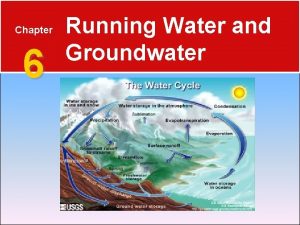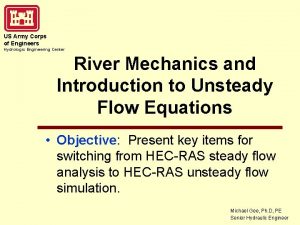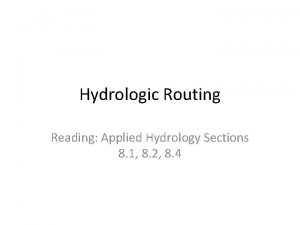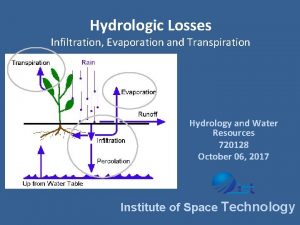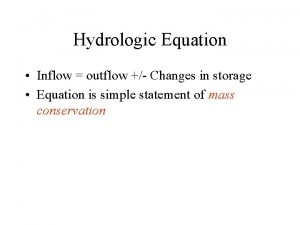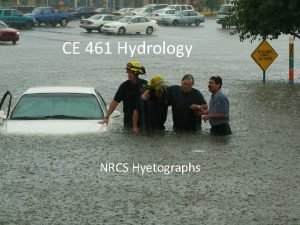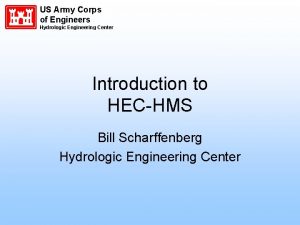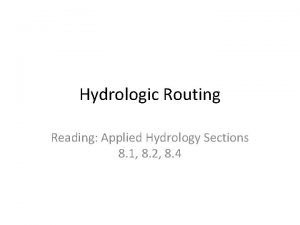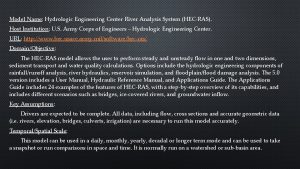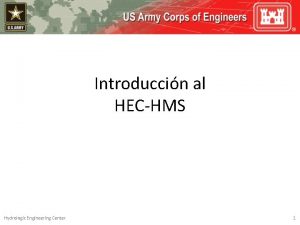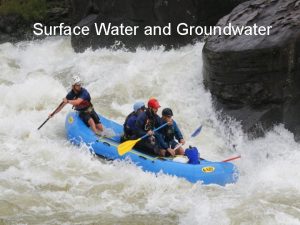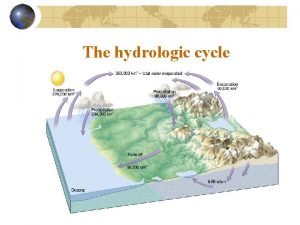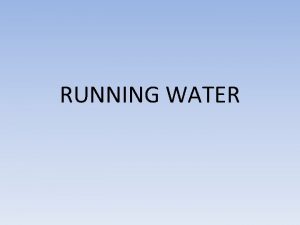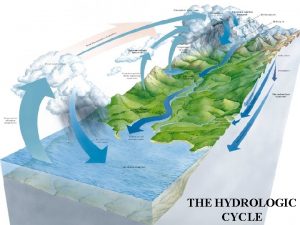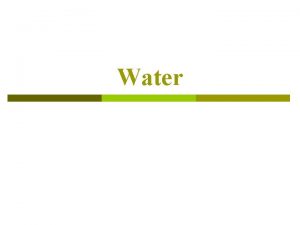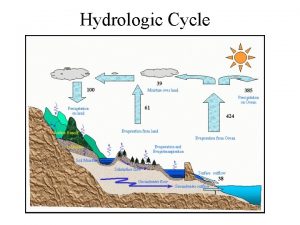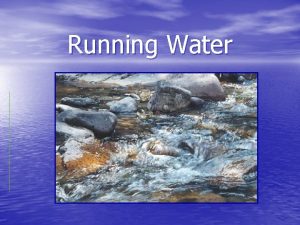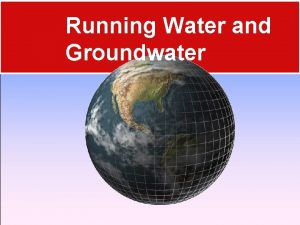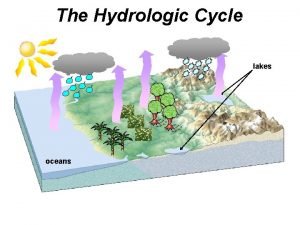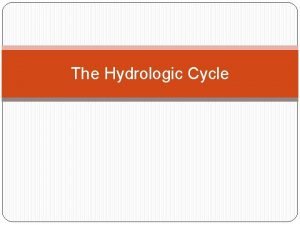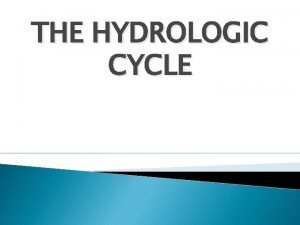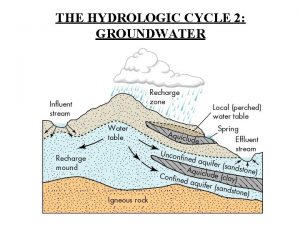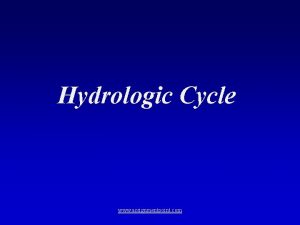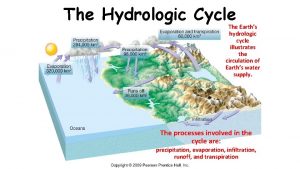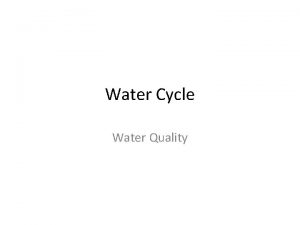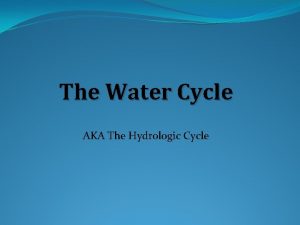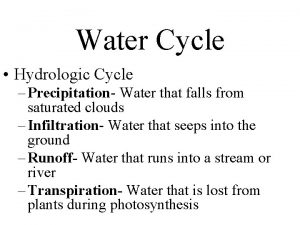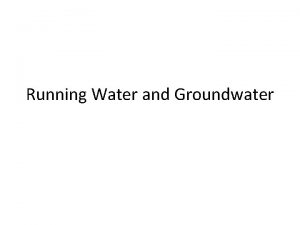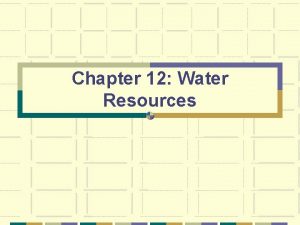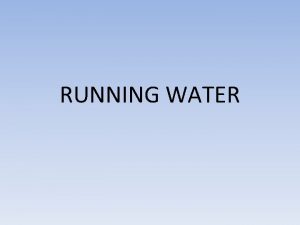Chapter 16 Running Water Hydrologic cycle The hydrologic











































- Slides: 43

Chapter 16: Running Water

Hydrologic cycle The hydrologic cycle is a summary of the circulation of Earth’s water supply Processes involved in the hydrologic cycle • Precipitation • Evaporation • Infiltration • Runoff • Transpiration

The hydrologic cycle

Sources of Earth’s water

Running water Begins as sheetflow • Infiltration capacity is controlled by – Intensity and duration of rainfall – Prior wetted condition of the soil – Soil texture – Slope of the land – Nature of the vegetative cover • Sheetflow develops into tiny channels called rills

Running water Streamflow • Two types of flow determined primarily by velocity – Laminar flow – Turbulent flow • Factors that determine velocity – Gradient, or slope – Channel characteristics including shape, size, and roughness

Running Water Streamflow • Factors that determine velocity – Discharge – the volume of water moving past a given point in a certain amount of time Changes from upstream to downstream • Profile – Cross-sectional view of a stream – Viewed from the head (headwaters or source) to the mouth of a stream

Running water Changes from upstream to downstream • Profile – Profile is a smooth curve – Gradient decreases downstream • Factors that increase downstream – Velocity – Discharge – Channel size

Longitudinal profile of a stream

Running water Changes from upstream to downstream • Factors that decrease downstream – Gradient – Channel roughness Base level and graded streams • Base level is the lowest point to which a stream can erode


Running water Base level and graded streams • Two general types of base level – Ultimate (sea level) – Local or temporary • Changing conditions causes readjustment of stream activities – Raising base level causes deposition – Lowering base level causes erosion

Adjustment of base level to changing conditions

Running water Stream erosion • Lifting loosely consolidated particles by – Abrasion – Dissolution • Stronger currents lift particles more effectively

Active erosion by a stream

Running water Transport of sediment by streams • Transported material is called the stream’s load • Types of load – Dissolved load – Suspended load – Bed load • Capacity – the maximum load a stream can transport

Running water Competence • Indicates the maximum particle size a stream can transport • Determined by the stream’s velocity

Running water Deposition of sediment by a stream • Caused by a decrease in velocity – Competence is reduced – Sediment begins to drop out • Stream sediments – Generally well sorted – Stream sediments are known as alluvium

Running water Deposition of sediment by a stream • Channel deposits – Bars – Deltas • Floodplain deposits – Natural levees – form parallel to the stream channel by successive floods over many years – Back swamps – Yazoo tributaries

Formation of natural levees by repeated flooding

Running water Deposition of sediment by a stream • Alluvial fans – Develop where a high-gradient stream leaves a narrow valley – Slopes outward in a broad arc

Running water Deposition of sediment by a stream • Deltas – Forms when a stream enters an ocean or lake

The Nile and Mississippi Rivers exhibit different types of deltas

Mississippi River Delta

Running water Stream valleys • The most common landforms on Earth’s surface • Two general types of stream valleys – Narrow valleys – V-shaped – Downcutting toward base level – Features often include rapids and waterfalls

Running water Stream valleys • Two general types of stream valleys – Wide valleys – Stream is near base level – Downward erosion is less dominant – Stream energy is directed from side to side forming a floodplain

Running water Stream valleys • Features of wide valleys often include – Floodplains – Erosional floodplains – Depositional floodplains – Meanders – Cut bank and point bar – Cutoffs and oxbow lakes

Erosion and deposition along a meandering stream

Erosion and creation of the floodplain


Running water Incised meanders and stream terraces • Incised meanders – Meanders in steep, narrow valleys – Caused by a drop in base level or uplift of the region • Terraces – Remnants of a former floodplain – River has adjusted to a relative drop in base level by downcutting

A meander loop on the Colorado River

Incised river in western Colorado


Running water Drainage Patterns Drainage Basin - the land area that contributes water to a stream. Drainage Divide - the topographic boundary that separates two drainage basins.



Running water Drainage networks • Pattern of the interconnected network of streams in an area • Common drainage patterns – Dendritic – Radial – Rectangular – Trellis

Drainage Patterns

Running water Floods and flood control • Floods are the most common and most destructive geologic hazard • Causes of flooding – Result from naturally occurring and humaninduced factors

Running water Floods and flood control • Flood control – Engineering efforts – Artificial levees – Flood-control Dams – Channelization – Nonstructural approach through sound floodplain management

Hoover dam

End of Chapter 10
 Water cycle the hydrologic cycle
Water cycle the hydrologic cycle Long long long ago there lived a little girl
Long long long ago there lived a little girl Running running running
Running running running Water and water and water water
Water and water and water water Chapter 6 running water and groundwater
Chapter 6 running water and groundwater How is the carbon cycle similar to the water cycle brainpop
How is the carbon cycle similar to the water cycle brainpop Hydrologic engineering center
Hydrologic engineering center Goodrich method
Goodrich method Hydrologic routing
Hydrologic routing Infiltration
Infiltration Storage equation
Storage equation Hydrologic abstractions
Hydrologic abstractions Hydrologic continuity equation
Hydrologic continuity equation Objectiveable
Objectiveable Continuity equation
Continuity equation Hydrologic engineering center
Hydrologic engineering center Hydrologic routing
Hydrologic routing River analysis system
River analysis system Hydrologic engineering center
Hydrologic engineering center Running water and groundwater
Running water and groundwater Types of running water
Types of running water Class 8 english chapter 7 water water everywhere
Class 8 english chapter 7 water water everywhere Chapter 11-9 the water cycle
Chapter 11-9 the water cycle Chapter 5 principles of engine operation
Chapter 5 principles of engine operation Hình ảnh bộ gõ cơ thể búng tay
Hình ảnh bộ gõ cơ thể búng tay Lp html
Lp html Bổ thể
Bổ thể Tỉ lệ cơ thể trẻ em
Tỉ lệ cơ thể trẻ em Gấu đi như thế nào
Gấu đi như thế nào Glasgow thang điểm
Glasgow thang điểm Alleluia hat len nguoi oi
Alleluia hat len nguoi oi Các môn thể thao bắt đầu bằng tiếng đua
Các môn thể thao bắt đầu bằng tiếng đua Thế nào là hệ số cao nhất
Thế nào là hệ số cao nhất Các châu lục và đại dương trên thế giới
Các châu lục và đại dương trên thế giới Công thức tiính động năng
Công thức tiính động năng Trời xanh đây là của chúng ta thể thơ
Trời xanh đây là của chúng ta thể thơ Cách giải mật thư tọa độ
Cách giải mật thư tọa độ 101012 bằng
101012 bằng Phản ứng thế ankan
Phản ứng thế ankan Các châu lục và đại dương trên thế giới
Các châu lục và đại dương trên thế giới Thể thơ truyền thống
Thể thơ truyền thống Quá trình desamine hóa có thể tạo ra
Quá trình desamine hóa có thể tạo ra Một số thể thơ truyền thống
Một số thể thơ truyền thống Cái miệng xinh xinh thế chỉ nói điều hay thôi
Cái miệng xinh xinh thế chỉ nói điều hay thôi




